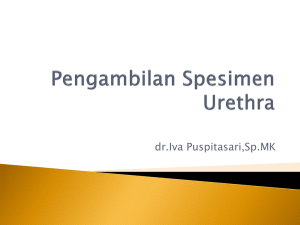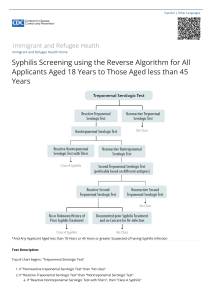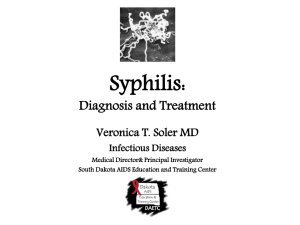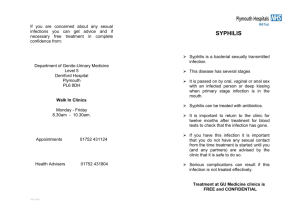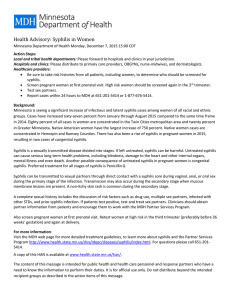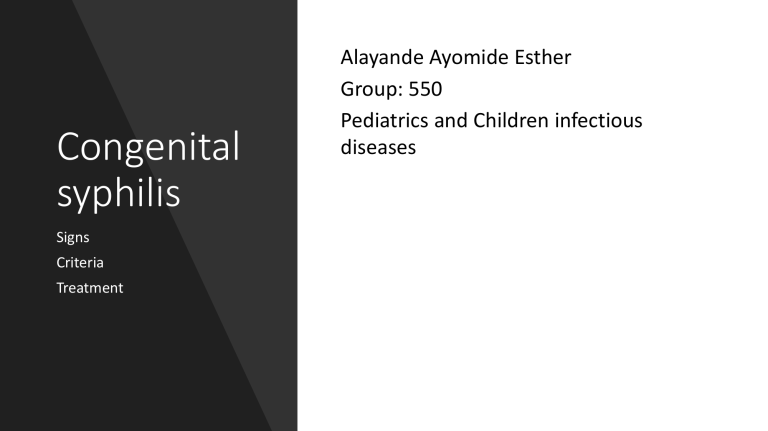
Congenital syphilis Signs Criteria Treatment Alayande Ayomide Esther Group: 550 Pediatrics and Children infectious diseases Signs and symptoms of early Congenital syphilis (birth–2 yrs) 1. Mucocutaneous manifestations • Persistent rhinitis (snuffles) • copper colored maculopapular or vesiculobullous lesions • Superficial desquamation involving hands and feet • Pemphigus syphiliticus • Condylomata lata • Mucous patches 2. Bone involvement. • Wimberger lines (demineralization of the medial proximal tibial metaphysis), • Multiple sites of osteochondritis at the wrists, elbows, ankles, and knees, and periostitis of the long bones and rarely the skull. The osteochondritis is painful, often resulting in irritability and refusal to move the involved extremity (pseudoparalysis of Parrot ). • Osteochondritis and periostitis Papulosquamous rash osteochondritis and periostitis Desquamation on the palm of a newborn's hand Perianal condylomata lata snuffles Pemphigus syphiliticus 3. Liver & spleen • hepatosplenomegaly & ascites • jaundice & hypoproteinaemia 4. Kidneys • Presence of hyaline , albumin & granular casts in urine • nephrotic syndrome 5. Lungs • infiltration of lungs is known as ‘white pneumonia or pneumonia alba’. 6. Ocular manifestations • glaucoma, cataract, • chorioretinitis and pigmentary chorioretinopathy (salt and pepper symptom) 7. Generalized lymphadenopathy 8. Hematologic manifestations • hemolytic anemia, thrombocytopenia Signs of late Congenital syphilis (>2 years of age) 1. Musculoskeletal • Olympian brow: Bony prominence of the forehead caused by persistent or recurrent periostitis • Clavicular or Higoumenaki's sign: Unilateral or bilateral thickening of the sternoclavicular third of the clavicle • Saber shins: Anterior bowing of the midportion of the tibia • Clutton joint: Unilateral or bilateral painless joint swelling (usually involving knees) from synovitis with sterile synovial fluid; spontaneous remission usually occurs after several weeks • Short maxilla , high arched palate • “Bull dog jaw” (prominent mandible) 2. Saddle nose: Depression of the nasal root, a result of syphilitic rhinitis destroying adjacent bone and cartilage 3. Rhagades: Linear scars that extend in a spoke-like pattern from previous mucocutaneous 4. Teeth • Hutchinson teeth:Peg-shaped upper central incisors; they erupt during 6th yr of life with abnormal enamel, resulting in a notch along the biting surface • Mulberry molars: Abnormal 1st lower (6 yr) molars characterized by small biting surface and excessive number of cusps 5. Hutchinson triad: Hutchinson teeth, interstitial keratitis, and 8th nerve deafness • Interstitial keratitis:Intense photophobia and lacrimation, followed within weeks or months by corneal opacification and complete blindness • 8th nerve deafness:May be unilateral or bilateral, appears at any age, manifests initially as vertigo and high-tone hearing loss, and progresses to permanent deafness 6. Neurosyphilis: Manifested as juvenile paresis, Juvenile tabes. . saddle nose Higoumenaki's sign saber shin Mulberry molars Interstitial keratitis Olympian brow Hutchinson teeth Clutton joint A presumptive case of congenital syphilis is when either of the following conditions are present: Suggestive findings 1. any infant whose mother had untreated or inadequately treated syphilis at delivery, regardless of findings in the infant; or 2. any infant or child who has a reactive treponemal test for syphilis and any one of the following: • any evidence of congenital syphilis on physical examination • any evidence of congenital syphilis on long bone xray; • reactive cerebrospinal fluid Venereal Disease Research Laboratory • elevated cerebrospinal fluid cell count or protein (without other cause) • quantitative nontreponemal serological titres which are fourfold higher than the mother’s (both drawn at birth); or • reactive test for IgM antibody by an approved method Diagnosis • Treponema pallidum is identified by darkfield microscopy of skin lesions, nasal discharge, placental tissue or amniotic fluid • Infant with positive VDRL plus pathognomonic signs • Most helpful specific test is IgM-FTA-ABS (immunoglobin fluorescent treponemal antibody absorption) but it is not always positive immediately. • A presumptive serological diagnosis may also be made when: i. an infant’s nontreponemal titre (VDRL or RPR) is fourfold higher than that of the mother when both blood samples are drawn at the time of delivery ii. the infant’s nontreponemal titre (VDRL or RPR) persists or increases after birth; or iii. the infant’s treponemal antibody titre (FTA-ABS and/or MHA-TP) remains positive at 12 to 18 months of age. Treatment I. Congenital syphilis in newborns: Aqueous crystalline penicillin G.100,000150,000 U/kg/d IV q8-12h for 10-14 days II. Congenital syphilis in older infants and children: Aqueous crystalline penicillin 200,000-300,000 U/kg/d IV q6h for 10-14 days. III. Neurosyphilis: Aqueous crystalline penicillin G, 200,000-300,000 U/kg/d IM (50,000 U/kg q4-6h) for 10-14 days, Followed by a single dose of benzathine penicillin 50,000 U/kg/dose in 3 weekly doses. CONGENITAL SYPHILIS IS PREVENTABLE!!! References: • https://www.slideshare.net/sonalpatel120/congenital-syphillis-ppt-use-in-obg-and-msn • https://www.slideshare.net/swethapanneer/congenital-syphilis-37850099 • https://www.slideshare.net/AimmyKhumpuangdee/congenitalsyphilis • https://www.cdc.gov/ncbddd/birthdefects/surveillancemanual/quick-referencehandbook/congenital-syphilis.html • https://emedicine.medscape.com/article/969023-workup#c7 • https://www.ncbi.nlm.nih.gov/pmc/articles/PMC2819963/#:~:text=A%20confirmed%20 case%20of%20congenital,umbilical%20cord%20or%20autopsy%20material. • Nelson Textbook of Pediatrics, 2-Volume Set by Robert M. Kliegman Joseph St Geme (zlib.org).pdf Abbreviations: VDRL (Venereal Disease Research Laboratory) RPR (Rapid Plasma Reagin) FTA-abs (Fluorescent Treponemal Antibody -Absorbed) MHA-TP(Microhemagglutination Assay for Treponema Pallidum antibodies)
